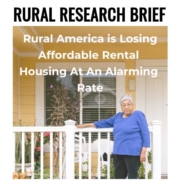News Formats. pdf
July 12, 2019
Vol. 48, No. 14
Rural rental preservation bill passes House committee unanimously • HUD’s mixed-status families proposal receives comments and analysis • USDA offers funds for farmworker housing and issues new guidance on renting to H-2A workers • Funding available to provide housing and services for victims of human trafficking • Census to proceed without citizenship question • Legality of ERS/NIFA relocation challenged • Deadlines extended for mortgage data comments • Affordable rental housing significantly further out of reach now than in 1989 • RuralSTAT • OMB publishes 2019 Compliance Supplement for federal audits • Unsheltered and Uncounted: Rural America’s Hidden Homeless • Americans in the Most Financially Distressed Zip Codes are Trapped in a ‘Really Troubling’ Catch-22 • The Education Deserts of Rural America • 2019 Kids Count Data Book • Rural America Faces Housing Shortage. How One Town is Addressing It • Rural Electrification 2.0: The Transition to a Clean Energy Economy • HAC is hiring! • HAC and Fannie Mae to hold webinars on colonias in New Mexico and Arizona • HAC offers Section 502 packaging training for nonprofits, August 6-8 in Michigan • Need capital for your affordable housing project?
HAC News Formats. pdf
July 12, 2019
Vol. 48, No. 14
Rural rental preservation bill passes House committee unanimously.
The Strategy and Investment in Rural Housing Preservation Act, H.R. 3620, was approved by the House Financial Services Committee in a 57-0 vote on July 11. Introduced by Rep. William Lacy Clay (D-MO) and Emanuel Cleaver (D-MO), the bill would authorize the MPR and preservation technical assistance programs, authorize vouchers for tenants after a mortgage matures or is foreclosed (in addition to after prepayment), allow decoupling of Rental Assistance as a last resort, require USDA to develop a preservation plan, and establish a stakeholders’ committee to advise USDA.
HUD’s mixed-status families proposal receives comments and analysis.
HUD received nearly 29,000 comments on its proposed rule that would require landlords to evict tenants whose immigration status makes them ineligible for aid, even if other members of the family are eligible. HAC provided comments opposing the regulation. Analysis by the Center on Budget and Policy Priorities found that 95% of those who would be impacted by the rule are people of color, including 85% who are Latinx, 56% female, and 53% children. Another proposed change that would require tenants to verify their citizenship or immigration status would impact 9 million citizens currently receiving HUD rental assistance, 72% of them people of color, 39% children and 17% seniors. The Center for Migration Studies estimates up to 11.5 million people could lose eligibility for housing assistance under the proposal.
USDA offers funds for farmworker housing and issues new guidance on renting to H-2A workers.
Nonprofits, tribes and government entities are eligible to submit pre-applications for Section 514 loans and Section 516 grants to develop off-farm housing for farmworkers. The deadline is August 30. USDA has also published an Unnumbered Letter dated May 30, 2019 that replaces a July 5, 2018 UL and provides information about allowing farmworkers with H-2A visas to live in Section 514/516 housing. The new UL includes more details than the 2018 version. For more information, contact a USDA RD state office.
Funding available to provide housing and services for victims of human trafficking.
HUD and the Department of Justice will make grants to nonprofits, for-profits, local or state governments and tribes to provide safe housing and specialized services to assist victims of human trafficking. Applications are due October 30. For more information, contact Sherri L. Boyd, HUD.
Census to proceed without citizenship question.
On June 11, President Trump issued an Executive Order instructing federal agencies to provide the Commerce Department any data they have that might help determine numbers of citizens and non-citizens. The order says the Supreme Court’s recent decision questioning the Administration’s rationale for including a citizenship question on the 2020 Census left “no practical mechanism” for making the question part of the census. It also states that obtaining accurate data on total numbers of citizens and non-citizens “has nothing to do with enforcing immigration laws against particular individuals” and records will continue to be confidential.
Legality of ERS/NIFA relocation challenged.
Politico reports that NBL Associates, the landlord that leases Washington, DC space to USDA’s National Institute of Food and Agriculture, filed a formal complaint (subscription required) on June 28 with the Government Accountability Office. NBL charges that USDA’s search for new space for NIFA and the Economic Research Service violates federal procurement law. It argues the process should begin again and should include the DC area. USDA has not changed its plans to move employees to temporary office space in Kansas City beginning by August 1, but it did change its deadline to August 7 rather than July 7 for bids from building owners in the Kansas City area.
Deadlines extended for mortgage data comments.
In May, CFPB requested comments on two proposals that could limit available Home Mortgage Disclosure Act data. The deadline for input on data points that are currently collected was July 8 but has been changed to October 15. The bureau also announced it will reopen the comment period on some aspects of a proposed rule to exempt lenders that originate small numbers of mortgages, but the official document has not yet appeared in the Federal Register.
Affordable rental housing significantly further out of reach now than in 1989.
Out of Reach 2019 marks the 30th anniversary of this National Low Income Housing Coalition report. In the late 1980s housing assistance reached only one in three eligible households, but today that figure is fewer than one in four. The report’s interactive site provides data for every county, state, and metro area.
RuralSTAT.
More than 3.5 million rural workers are employed in the manufacturing sector. Manufacturing comprises 14% of rural jobs compared to 10% nationally. To learn more about industry and employment in your community visit HAC’s Rural Data Portal.
OMB publishes 2019 Compliance Supplement for federal audits.
The annual supplement to OMB’s Uniform Administrative Requirements, Cost Principles, and Audit Requirements for Federal Awards applies to audits of entities that use any of a lengthy list of federal housing programs.
Recent publications and media of interest
- Unsheltered and Uncounted: Rural America’s Hidden Homeless, a National Public Radio story, examines the growing problem of rural homelessness, where challenges in getting accurate counts still persist. Additionally, according to organizations working with the rural homeless in Kentucky, people are now less likely to be doubling up in crowded houses and more likely to sleep outdoors or in cars.
- Americans in the Most Financially Distressed Zip Codes are Trapped in a ‘Really Troubling’ Catch-22 reports on an Economic Innovation Group analysis that found the most distressed zip codes are concentrated in the Southeast, rural West, and urban centers in the Northeast and Midwest, places that have the country’s most persistent pockets of really entrenched poverty. Rural areas are projected to never fully recover from the Great Recession and a lack of job opportunities continues to make rural areas less appealing places to live, the article says.
- The Education Deserts of Rural America notes that the high-school education gap between urban and rural students has decreased but the college-completion gap has widened. (The author uses Economic Research Service data.) Rural students often have to travel greater distances than their urban peers to attend college, limited broadband access eliminates online education as an option, and many states have disinvested in public higher education.
- 2019 Kids Count Data Book is the 30th edition of the Annie E. Casey Foundation’s compilation of figures. The foundation reports that 11 of the 16 areas of child well-being it tracks have improved since 1990, though housing cost burden rates increased. Racial and ethnic disparities persist. Data are provided for the U.S. and each state.
- Rural America Faces Housing Shortage. How One Town is Addressing It looks at how a town in Nebraska and other rural communities are addressing the need for more affordable housing, especially workforce housing. The piece quotes HAC CEO David Lipsetz and references HAC’s research on the looming rural rental housing crisis.
- Rural Electrification 2.0: The Transition to a Clean Energy Economy reports that while many rural areas in the United States provide the infrastructure for clean energy, the power generated is not used locally. Rural electric cooperatives derive two-thirds of their energy from fossil fuels. The report authors argue that the decreasing cost of producing wind- and solar-powered energy makes the transition to renewable resources more affordable and makes economic sense in the long run.
HAC is hiring!
Housing Specialist: based primarily in the Southwest or Western U.S. to provide direct technical assistance, coaching and training to nonprofits, government agencies and others.
Portfolio Manager: based in DC to manage a portfolio of loans made to entities engaged in affordable housing activities in rural communities.
Both positions come with competitive salaries, generous benefits and the opportunity to work in a fun and mission-focused environment.
HAC and Fannie Mae to hold webinars on colonias in New Mexico and Arizona.
HAC, in partnership with Fannie Mae, will hold webinars in July and August presenting data and research on Colonias Investment Areas, a geographic concept developed to target mortgage finance and resource investment in colonia communities along the southwest U.S. border. A webinar on July 17 will focus on New Mexico, and one on August 7 will focus on Arizona. For more information, contact HAC staff, 404-892-4824.
HAC offers Section 502 packaging training for nonprofits, August 6-8 in Michigan.
This three-day advanced course trains experienced participants to assist potential borrowers and work with RD staff, other nonprofits and regional intermediaries to deliver successful Section 502 loan packages. The training will be held in East Lansing, MI on August 6-8. For more information, contact HAC staff, 404-892-4824.
Need capital for your affordable housing project?
HAC’s loan funds provide low interest rate loans to support single- and multifamily affordable housing projects for low-income rural residents throughout the U.S. and territories. Capital is available for all types of affordable and mixed-income housing projects, including preservation, farmworker, senior and veteran housing. HAC loan funds can be used for pre-development, site acquisition, site development and construction/rehabilitation. Contact HAC’s loan fund staff at hacloanfund@ruralhome.org, 202-842-8600.
Please note: HAC is not able to offer loans to individuals or families. Borrowers must be nonprofit or for-profit organizations or government entities (including tribes).


 Housing Assistance Council
Housing Assistance Council